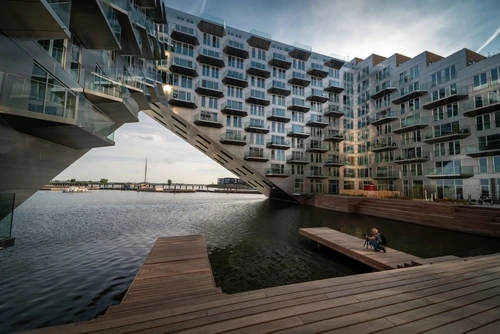
Last year’s opening of Sluishuis – a cantilevered residential wedge bridging the expanding artificial archipelago of IJburg and Amsterdam – highlights how building island cities has been front and centre of the Dutch planning model.

Despite the stop-start legal and technical machinations that beset island building, their global popularity keeps growing.
Island cities: the Dubai development model
One of the most interesting conversations I had during the two years I spent researching new islands (The Age of Islands; published in the USA as Elsewhere), was in the plush surroundings of Nakheel, Dubai’s state developer. It’s where many of the planet’s iconic new islands were dreamed up but what really impressed me was their visitor list. “We have a lot of governments coming to learn from us,” I was told, “from China, South Korea and now from Africa as well. We get a lot of people wanting to emulate what we have done.”
Although critics in the West might tut, the outlandish island schemes of Dubai and its neighbours are seen by many Asia and Africa as a success story and the way to go. The combination of high-profile glamour and eager investors is hard to resist. The candyfloss appeal of many of these oddly shaped creations also helps explain why some get called things like ‘Funtasy Island’, which is the name given to a new Indonesian ‘eco-resort’ that is expected to be completed this year. Funtasy Island’s biggest selling point is that it is a 20-minute boat ride from Singapore.
More serious Dubai-style fun can be had at Eko Atlantic, Lagos’s ‘Manhattan in the sea’, a $6bn development fitfully coming together off the coast of Victoria Island. Despite setbacks and scandals, like many other ritzy offshore developments, the sand continues to be piled up, and the grand boulevards of Eko Atlantic are starting to emerge from the waves.
Exclaving wealth
The most reliable market for urban artificial islands is wealthy people who want to live in the city but do not want to put up with its traffic, dirt and insecurity. That is key to the appeal of Eko Atlantic and it’s a common aspiration. Islands take the idea of the gated enclave one step further, creating exclaves of privilege that are super visible but are impossible for ordinary mainlanders to access (unless they are cleaners, chauffeurs or gardeners).
One of the most striking examples is Ocean Reef, a two-island complex that glitters just a skimming stone distance from downtown Panama City. It has its own underwater sensors and marine security force. All these devices help ensure that that the country’s elite families (who are the ones moving in) can walk on manicured lawns and hear the gentle roll of the Pacific while being a few minute’s ride from the pounding highways of the city.
After embarrassing myself with some blundering nonsense about being ‘in the market’, I did manage to get ashore. My attempts to pose as a customer instantly evaporated under the warm smile of the affable realtor who showed me around. I think he took pity on me. He stressed that Ocean Reef offers something precious now lost on the mainland, ‘community’. The community vibe is helped by the fact that most buyers already know each other, including his own: it’s “selling to friends”, he explained.
Risky times
The world’s most ambitious new islands are taking shape off the coast of China, notably, the resorts amassing around ‘China’s Hawaii’, the island province of Hainan. China also provides key examples of the military and territorial value of new islands. With each new speck giving its nation 200 extra nautical miles of territory, it has not taken long for China to lay claim to almost the whole of the South China Sea.
The Chinese islands I visited were much less scary, soaking up some of the surplus income of mainlanders who fancy a staycation in the tropical sun. But they are still a site of conflict. On the largest, Ocean Flower, whose petals swirl across nearly four square kilometres, the government has demanded the demolition of 39 high-rise towers, citing environmental and construction problems. This has only added to the woes of the developer, Evergrande, which is reeling under an incredible $300bn in debt and struggling to repay creditors.
Despite the glitz that sticks to them, artificial islands come with serious challenges. But they can also offer serious solutions. You only have to look at the Maldives, where Hulhumalé, branded the ‘City of Youth’ and the ‘City of Hope’, has been built 2m above sea level on a coral reef, to provide a safe haven for about half the country’s population. Another new island, Thilafushi, shows us another key use: this is where the Maldives’ garbage is dumped and its unsightly and polluting industries are hidden from view.
Barrier islands have shown themselves to be essential tools for protecting coastal communities. Such defensive islands proved their worth during Hurricane Ida and are going to be increasingly necessary to save our coasts. But all artificial islands require maintenance and have a limited lifespan. In the Netherlands, these challenges are far from new but they’re taking on a new urgency.
Amsterdam is 2m below sea level and is plugged into an unrivalled national network of locks, dams and pumping stations. But scientists predict that much of this impressive network has a useful life of less than three decades. Seas are rising faster than expected, with the real possibility of unpredictable and rapid surges as polar ice reaches a tipping point.
Artificial islands remain a go-to solution worldwide but as a residential option, in the medium and longer term, they carry huge risks.
[Read more: So what’s with all these new planned cities?]






